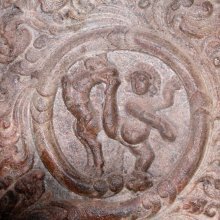Shakatasura, Śakaṭāsura, Shakata-asura: 2 definitions
Introduction:
Shakatasura means something in Hinduism, Sanskrit. If you want to know the exact meaning, history, etymology or English translation of this term then check out the descriptions on this page. Add your comment or reference to a book if you want to contribute to this summary article.
The Sanskrit term Śakaṭāsura can be transliterated into English as Sakatasura or Shakatasura, using the IAST transliteration scheme (?).
Images (photo gallery)
In Hinduism
Shilpashastra (iconography)
Source: Archaeological Survey of India: Śaiva monuments at Paṭṭadakal (śilpa)Śakaṭāsura (शकटासुर) is depicted as a sculpture on the second pillar of the southern half of the maṇḍapa of the temple of Lokeśvara.—A cart is carved at the feet of the baby Kṛṣṇa. Kaṃsa sent another demon named Śakaṭāsura. Assuming the form of a cart he came to kill the child, but Kṛṣṇa, just with a kick, reduced him into pieces. According to Bhāgavata and other texts, at the time of this exploit Kṛṣṇa was a three month old baby. Śakaṭāsura is shown in the form of a wheel and a head emanating from it with hands folded, as an expression of his surrender.

Shilpashastra (शिल्पशास्त्र, śilpaśāstra) represents the ancient Indian science (shastra) of creative arts (shilpa) such as sculpture, iconography and painting. Closely related to Vastushastra (architecture), they often share the same literature.
General definition (in Hinduism)
Source: Wisdom Library: HinduismSakaṭāsura (सकटासुर, “wheel-demon”) is the Sanskrit name of a demon (asura) sent by Kaṃsa (Kṛṣṇa’s maternal uncle) to kill Kṛṣṇa. These efforts did not succeed.
See also (Relevant definitions)
Partial matches: Sakata, Asura.
Starts with: Shakatasurabhanjana, Shakatasurasamharagopalamantra.
Relevant text
Search found 10 books and stories containing Shakatasura, Śakaṭāsura, Shakata-asura, Śakaṭa-asura, Sakatasura, Sakata-asura, Sakaṭāsura; (plurals include: Shakatasuras, Śakaṭāsuras, asuras, Sakatasuras, Sakaṭāsuras). You can also click to the full overview containing English textual excerpts. Below are direct links for the most relevant articles:
Garga Samhita (English) (by Danavir Goswami)
Verse 2.18.25 < [Chapter 18 - The Sight of Śrī Kṛṣṇacandra]
Chapter 14 - The Liberation of Śakaṭāsura and Tṛṇāvarta < [Canto 1 - Goloka-khaṇḍa]
Śrī Kṛṣṇa Aṣṭottara-śata Nāmavaḷḷiḥ
Tiruvaymoli (Thiruvaimozhi): English translation (by S. Satyamurthi Ayyangar)
Pasuram 2.1.8 < [Section 1 - First Tiruvaymoli (Vayum tirai)]
Brihad Bhagavatamrita (commentary) (by Śrī Śrīmad Bhaktivedānta Nārāyana Gosvāmī Mahārāja)
Verse 1.7.143 < [Chapter 7 - Pūrṇa (pinnacle of excellent devotees)]
Verse 1.7.157-158 < [Chapter 7 - Pūrṇa (pinnacle of excellent devotees)]
Vasudevavijaya of Vasudeva (Study) (by Sajitha. A)
Theme of the Vāsudevavijaya < [Chapter 2 - Vāsudevavijaya—Authorship and Content Analysis]
Shrimad Bhagavad-gita (by Narayana Gosvami)
Verse 10.3 < [Chapter 10 - Vibhūti-yoga (appreciating the opulences of the Supreme Lord)]
